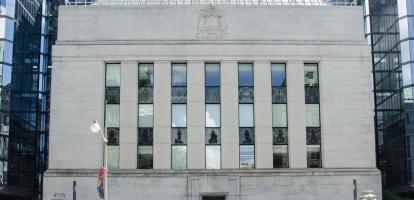The Bank of Canada again held its target for the overnight rate at 5 per cent on Wednesday, as expected.
The clamoring had begun for the bank to consider dropping rates in hopes that inflation is headed back to 2 per cent. However, the latest numbers (for December) disappointed, with headline inflation ticking back up to 3.4 per cent (from 3.1 per cent), and core measures flat or, in the case of CPI-Trim, slightly higher. On Wednesday, the bank stressed upside risks to inflation coming from greater-than-expected persistence.
However, the announcement did not mention geopolitical risks, particularly the effect of the disruption of maritime traffic in the Red Sea, its impact on shipping costs, and the knock-on effects on inflation. We think this risk is important and that the bank should address it more directly.
If inflation spikes as a result of these disruptions, what should the Bank of Canada do and how should this affect the bank’s communication?
Because of the Middle East tensions, container ships have been avoiding the Red Sea and Suez Canal, through which 12 per cent of global trade flows. The Shanghai Containerized Freight Index, which measures non-contract spot rates for container shipments out of China’s ports – a measure of how expensive shipping costs are – increased by 16 per cent in the week before Jan. 12.
Rerouting a ship around Africa, which companies must now do, adds 10 days and over $1-million in fuel costs to a trip between Europe and Asia. In addition, it increases the number of ships in transit, instead of loading and unloading in port, causing a reduction in the effective supply of shipping capacity, leading to shortages. Major importers have announced product shortages and/or warned of late-arriving goods. Increased import costs will lead to increased wholesale and retail costs, and with it, higher inflation.
A spike in inflation caused by increasing transportation costs is a classic supply-side shock in economics parlance – a problematic situation for the bank.
Assume demand and supply are in balance and their curves intersect with inflation at 2 per cent. The two types of shocks that can push inflation above 2 per cent are a negative supply shock and a positive demand shock. Unlike a positive demand shock that pushes inflation above 2 per cent as economic activity increases, a negative supply shock depresses economic activity but lifts prices amid shortages. If the bank needs to bring inflation down in these circumstances, the hike to its policy rate will exacerbate the already-slumping economy.
Following a two-year fight with above target inflation, the bank hopes to complete inflation’s return to 2 per cent while engineering a soft landing for the economy, which means avoiding pushing it into a recession. Further increases in the policy rate, given the current weakness of the economy, could very well bring about a recession.
However, if the shock is persistent and inflation remains high, the danger with leaving rates unchanged would be that high inflation becomes baked into inflation expectations. The trust households and businesses have in the bank’s willingness to do what’s necessary to hit the 2 per cent target would be under threat. This would encourage firms to increase their prices at a faster rate and also encourage a more rapid increase in wages and salaries.
The bank will likely be forced to thread the needle between not exacerbating a downturn caused by an increase in shipping costs while at the same time not letting inflation expectations become unanchored.
For now, we would recommend that the bank adopt a wait and see attitude in response to this supply-side shock. The way to prevent any de-anchoring of expectations is through clear and transparent communication. The bank should get ahead of the curve. Its next announcement should not only address this as an upside risk, but also make clear that the bank will look through any resulting increase in inflation as long as it is temporary – defining what that means – and explain why.
This could include presenting and explaining the kind of breakdown of inflation into demand-driven and supply-driven components calculated by Sonja Chen and Trevor Tombe and regularly updated by the C.D. Howe Institute. The bank could explain from one announcement to the next how the breakdown changed, what factors were responsible – in this example, the conflict in the Middle East – and whether they expect the shock to be sufficiently temporary to leave rates unchanged.
Supply-side shocks complicate the lives of central bankers. The bank must walk the tightrope between looking through events they have no control over, like geopolitical tensions, and not losing the credibility of hitting their 2 per cent inflation target. For now, best for the bank to leave rates unchanged.
Jeremy Kronick is associate vice-president and director of the Centre on Financial and Monetary Policy at the C.D. Howe Institute, where Steve Ambler, a professor of economics, Université du Québec à Montréal, is the David Dodge Chair in Monetary Policy.





